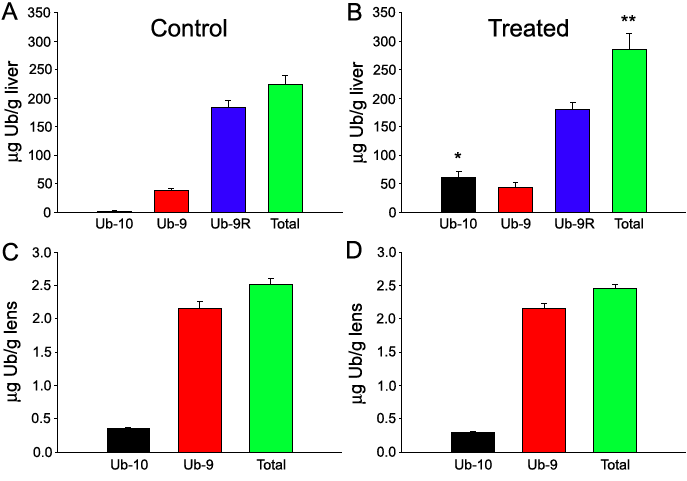![]() Figure 5 of
Cenedella, Mol Vis 2005;
11:594-602.
Figure 5 of
Cenedella, Mol Vis 2005;
11:594-602.
Figure 5. Effect of dietary supplementation with ubiquinone-10 on the ubiquinone levels of rat liver and lens
Starting at 20 days of age, Sprague-Dawley rats were fed chow containing Ub-10 for 17 days. The dose was approximately 200 mg Ub-10/kg body weight per day. Samples of liver from individual rats (0.35-0.54 g) and pools of whole lenses (4-6 lenses) were homogenized and the ubiquinones extracted. The ubiquinones were fractionated as ubiquinone-10 (Ub-10), ubiquinone-9 (Ub-9), and ubiquinone-9 reduced (Ub-9R; ubiquinol-9). A: Liver from control rats (n=6). B: Livers from treated rats (n=6). The single asterisk indicates that the concentration of Ub-10 in the liver of treated rats is statistically different from the concentration in the liver of untreated-control rats to a P(t) value of less than 0.0001 measured by the Students t test. The double asterisk indicates that the difference in total Ub concentration in the liver of treated compared to control was note quite statistically significant (to only a P(t) of 0.09). This is because the level of reduced Ub-9, which accounts for the major Ub in rat liver, was not increased. C: Lens from control rats (3 pools of 4-6 lenses). D: Lens from treated rats (4 pools of 4 lenses). Error bars represent the standard error of the mean.
